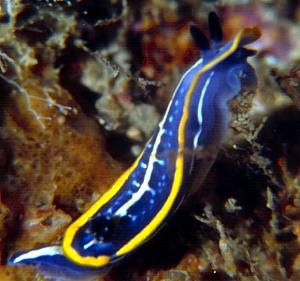
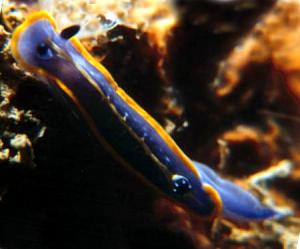
Hypselodoris tricolor
(Cantraine, 1835)
Order: NUDIBRANCHIA
Suborder: DORIDINA
Superfamily: EUDORIDOIDEA
Family: Chromodorididae
DISTRIBUTION
Western Mediterranean, and adjacent eastern Atlantic
PHOTO
Bay of Algeciras (Strait of Gibraltar, Southern Spain) at 20 m. depth (17.6ºC), Size: 25 mm. Place: La Seca Reef. May, 2000. Photos: Alma Sánchez.
One of a large group of similarly coloured blue chromodorids from the Mediterranean and adjacent Atlantic waters. Reported to feed on the sponges Dysidea avara and Dysidea fragilis. Also reported on the Forum to feed on the thorectid sponge Scalarispongia scalaris.
Reference:
• Ortea, J., Valdés, A. & and García-Gómez, J.C. (1996) Revisión de las especies atlánticas de la familia Chromodorididae (Mollusca: Nudibranchia) de grupo cromático azul. [Review of the Atlantic species of the family Chromodorididae (Mollusca: Nudibranchia) of the blue chromatic group.] Avicennia, 1996, Suppl. 1: 1-165.
See message below suggesting that Doris tricolor is unidentifiable and we should use H. midatlantica Gosliner, 1990 for this species
Authorship detailsRudman, W.B., 2001 (February 11) Hypselodoris tricolor (Cantraine, 1835). [In] Sea Slug Forum. Australian Museum, Sydney. Available from http://www.seaslugforum.net/find/hypstric
Related messages
Hypselodoris tricolor from Brittany
September 9, 2009
From: Wilfried Bay-Nouailhat

Concerning message #22641:
Dear Bill,
Here are two pictures of what I think is Hypselodoris tricolor. We saw them in South Brittany (West of France) which is far more in the North than the usual distribution of this species. Could you please confirm this identification ?
Locality: Iles Glenan, 28 m, Brittany, France, Atlantic Ocean, 30 august 2009, Rock. Length: 2.5 - 3 cm. Photographer: Wilfried Bay-Nouailhat.
Best regards
Anne and Willy
contact@mer-littoral.org



Thanks Willy,
Although I am not entirely confident identifying the blue Atlantic chromodorids, this certainly looks like H. tricolor to me. If so, it is certainly a bit further north than normally reported. The white sponge the animals are interested in is certainly a species of Dysidea, and could well be Dysidea fragilis.
Best wishes,
Bill Rudman
Hypselodoris tricolor feeding
September 4, 2009
From: Antoni López-Arenas i Cama


Concerning message #16919:
Hi Bill,
Here comes a pair of photos of Hypselodoris tricolor feeding on a pink sponge Dysidea avara as you asked.
Locality: La depuradora, l'Escala, Costa Brava., 22 metres, Spain, Mediterranean, 30 May 2009, Pre-coraligen. Length: 10 - 20 mm. Photographer: Antoni López-Arenas i Cama.
Glad to participate
Antoni
http://bitxosdelmediterrani.blogspot.com
http://www.flickr.com/photos/alopezarenas/sets/72157603891082971/
alopezarenas@gmail.com
López-Arenas, A., 2009 (Sep 4) Hypselodoris tricolor feeding. [Message in] Sea Slug Forum. Australian Museum, Sydney. Available from http://www.seaslugforum.net/find/22641
Dear Antoni,
Thanks again. As I said in your message of H. fontandraui feeding [message #22640], I suspect the white sponge in that message and the pink one in this message may be two different species of Dysidea. I a not an expert on sponges, but I would agree that this pink one is 'typical' of D. avara. Your photo has a remarkable similarity to ones in Baki Yokes' earlier message from Turkey [#5338 ].
Species of Hypselodoris usually feed on species of the sponge family Dysideidae, but there was one Mediterranean species, Hypselodoris orsinii, which fed exclusively on thorectid sponges of the genera Cacospongia and Scalarispongia. Earlier records on the Forum [#22390] show that H. tricolor is unique in feeding on both thorectid and dysideid sponges. It is good to get more records confirming that they really do feed on both.
I look forward to further interesting photos in the future
Best wishes,
Bill Rudman
Re: Hypselodoris tricolor, on Cacospongia
April 3, 2009
From: M. Baki Yokes

Concerning message #22011:
Dear Bill,
I scanned all our photographic database, and found these photos, showing the same blue Hypselodoris species on a sponge other than Dysidea avara. These photos are from the same dive site as the photos of the same species feeding on Dysidea avara in my message #5338.
Locality: Saros Bay, Canakkale, Turkey, June 2001. Photographer: Hasan Yokes.
Best wishes
Baki
bakiyokes@turk.net



Dear Baki,
From the single whitish line on the outer edge of each gill this is certainly what Ortea, Valdes & Gomez (1996) define as Hypselodoris tricolor. It certainly seems from these photos and earlier ones on the Forum [#22011, #22013, #22014 ] that this species feeds on this grey sponge which Prof Bergquist identifies as Scalarispongia scalaris (rather than a species of Cacospongia ).
Until these records were posted, Hypselodoris orsinii was the only one of these Mediterranean blue chromodorids which could definitely be said to feed on thorectid sponges such as Cacospongia and Scalarispongia. There are a couple of earlier records in the literature of H. tricolor feeding on Cacospongia which I have listed below, but without photographs of the specimens observed, it is impossible to check the identity of the animals. In their review (Ortea, Valdes & Garcia-Gomez, 1996) report H. tricolor to feed on Dysidea and they report literature records of it containing the furanosesquiterpenes which is a metabolite associated with dysideids but not thorectids such as Scalarispongia.
This suggests that either H. tricolor feeds on both dysideid and thorectid sponges - which would be unique - or we are dealing with a pair of species mimicking each other. From looking at the photos on the Forum I can see no obvious or subtle differences but what would be really useful is to know the colour of the gills on the animals feeding on Dysidea. Unfortunately they are withdrawn in your photos [message #5338]. Have you other photos of the ones on Dysidea showing the gills?
-
Ros, J. (1978) La alimentación y el sustrato en los opistobranquios ibéricos. Oecologia aquatica, 3, 153-166.
-
Vicente, N. (1967) Contribution à l'étude des gastéropodes opisthobranches de Golfe de Marseille. 1.Systematique, ecologie, biologie. Recueil des travaux de la station marine d'Endoume - Marseille, 42, 133-179.
Thanks for following up on this exciting observation,
Best wishes,
Bill Rudman
Re: Hypselodoris tricolor on Cacospongia
November 4, 2008
From: Vincent Maran

Concerning message #22011:
Dear Bill
I am of course very happy for you to include these photos on the Sea Slug Forum which we appreciate very much as a reference work for us. With a lot of friends, we are trying to build a good website about marine biology : http://doris.ffessm.fr/
Concerning the photos of Hypselodoris tricolor on its sponge - we were just lucky ! to take these pictures. They were taken in August 2001 when diving near Marseille [20 m], on the mediterranean coast of France
Best wishes
Vincent Maran
vincent.maran@ac-lille.fr
Maran, V., 2008 (Nov 4) Re: Hypselodoris tricolor on Cacospongia. [Message in] Sea Slug Forum. Australian Museum, Sydney. Available from http://www.seaslugforum.net/find/22014
Dear Vincent,
Thanks for sharing these photos with us. On your website you write that the upper photos shows: 'A small group of H. tricolor on their favourite sponge, Cacospongia sp.'
I am glad Sylvain Le Bris drew our attention to your photos, because until now the scientific literature believed H. tricolor ate Dysidea. As I am sure you are aware, 'science' is still having trouble deciding how many species of blue chromodorids are to be found in the Mediterranean, and how we can identify them. Fortunately in your lower photo the animal has its gills extended so we can see that it has uniformly dark blue rhinophores and blue gills with a white line along the outer edge which are at present considered characters of H. tricolor.
Good luck and congratulations on your website. It contains many interesting and potentially valuable observations.
Best wishes,
Bill Rudman
Re: Hypselodoris tricolor on Cacospongia
November 4, 2008
From: Philippe Perrier


Concerning message #22011:
Here is a photo of mine showing Hypselodoris tricolor and its egg ribbon on the sponge Cacospongia. The ribbon is approx 5 mm high and the diameter of the whole egg mass is approximately 30 mm.
Locality: La Ciotat, Provence, France, Mediterranean coast, 16 m [dive site 'La Balise'], 2 August 2007. Photo: Philippe Perrier.
Philippe Perrier.

Dear Philippe,
Thanks so much for sending this photo. It certainly more evidence linking this species to the sponge Cacospongia. I can't find any illustration of the egg ribbon of this species, so I can't confirm it belongs to this species, but it most likely to be so. One early message to the Forum from Roberto Moresco is particularly interesting because he mentions that this species has feeding veliger larvae [message #407] and that the food of the adult is Cacospongia. His photo of the animal [message #500] shows it is identical to your animal in colour, and if the larvae feed in the plankton, their eggs would be small as in your photo.
Hypselodoris orsinii is at present the only species of Hypselodoris reported to feed on Cacospongia, but as it is known to produce large direct developing eggs [Ortea et. al, 1996], H. orsinii and H. tricolor are clearly two distinct species. Unfortunately the differences between the various 'blue chromodorids' in the Mediterranean are still confusing, and it seems that at least some of the biological reports in the literature, on feeding and egg masses, include misidentifications which are now impossible to resolve. To help us clarify the situation, photos such as yours are very valuable. Any other photos showing species on their food or laying egg ribbons would be very welcome.
-
Ortea, J., Valdés, A. & and García-Gómez, J.C. (1996) Revisión de las especies atlánticas de la familia Chromodorididae (Mollusca: Nudibranchia) de grupo cromático azul. [Review of the Atlantic species of the family Chromodorididae (Mollusca: Nudibranchia) of the blue chromatic group.] Avicennia, 1996, Suppl. 1: 1-165.
Best wishes,
Bill Rudman
Hypselodoris tricolor, on Cacospongia
November 3, 2008
From: Sylvain Le Bris

Concerning message #17160:
Dear Bill,
This picture shows Hypselodoris tricolor feeding on Scalarispongia scalaris. In your description you say this species only feeds on Dysidea.
You can find other pictures on this site :
http://doris.ffessm.fr/fiche2.asp?fiche_numero=205
Locality: Farillons, 30m, France, Mediterranean sea, 18 september 2007. Photographer: Sylvain Le Bris.
Sylvain Le Bris
lebris.sylvain@gmail.com



Dear Sylvain,
Thanks for this very interesting photo and the link showing other records of this species on the thorectid sponge Cacospongia. Until now the only species of Hypselodoris reported to feed on a thorectid was the other blue mediterranean species Hypselodoris orsinii. In Ortea et al (1996) H. tricolor is reported to feed on Dysidea avara, and Baki Yokes message from Turkey [#5338] seems to show it feeding on a species of Dysidea.
In an earlier message [#14085] you posted a photo showing one H. tricolor and one H. orsinii on Cacospongia, which I commented as being rather strange, wondering if the H. tricolor had been added to the photo. Clearly it hadn't.
While it is possible that H. tricolor feeds on both Dysidea and Cacospongia, a more likely situation is that records of it feeding on Dysidea are a misidentification of the nudibranch. I have looked carefully at Baki Yokes' photo and it is possible that the species is not H. tricolor as there does not seem to be a white or yellow edge to the upper part of the gills. It is possibly H. fontandraui but I am afraid I find parts of Ortea, Valdes & Garcia-Gomez's review confusing, so I cannot be sure. I guess this is why there has been considerable confusion in working out just what sponges these Mediterranean species of Hypselodoris feed on. It seems at least that H. tricolor joins H. orsinii in feeding on the thorectid sponge, Cacospongia, rather than species of the Dysideidae, which Hypselodoris normally feeds on.
If anyone can help re-identify the animals in Baki Yokes' message [#5338] I would be most grateful.
• Ortea, J., Valdés, A. & García-Gómez, J.C. (1996) Revisión de las especies atlánticas de la familia Chromodorididae (Mollusca: Nudibranchia) de grupo cromático azul. [Review of the Atlantic species of the family Chromodorididae (Mollusca: Nudibranchia) of the blue chromatic group.] Avicennia, 1996, Suppl. 1: 1-165.
Best wishes,
Bill Rudman
Hypselodoris tricolor, on a sponge
July 19, 2006
From: Stephane Ores
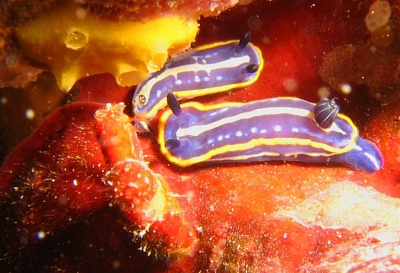
Hello Bill !
These two nudis seem to be Hypselodoris tricolor. I think they are feeding on a sponge. But as usually they feed on Dysidea avara, this sponge seems to be Petrosia ficiformis?
Locality: Rade de Villefranche, grotte du semaphore, 20, France, Mediterranean Sea, 12 July 2006, Good visibility. Length: 25 mm. Photographer: Stephane Ores.
thanks & best wishes
Stephane
stephane.ores@neuf.fr
Ores, S., 2006 (Jul 19) Hypselodoris tricolor, on a sponge. [Message in] Sea Slug Forum. Australian Museum, Sydney. Available from http://www.seaslugforum.net/find/17160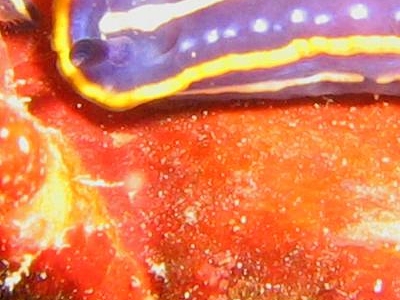
Dear Stephane,
Your animals certainly look like H. tricolor, and as you say the existing evidence suggests they feed on species of Dysidea, like most species of Hypselodoris. Interestingly there are a couple of records of 'Glossodoris tricolor' feeding on Petrosia (Ledoyer, 1968; Ros, 1975) but later authors have considered that the nudibranchs involved were probably H. orsinii. Not that that resolves the puzzle, because H. orsinii is itself anomalous in feeding on the thorectid sponge Scalarispongia scalaris.
Petrosia ficiformis is in an Order of sponges [Haplosclerida] that chromodorids are not reported to feed on, so my inclination is to say that the slugs are just crawling over this sponge. However the earlier suggestions that it may feed on Petrosia may be a total coincidence, but they suggest to me that it would be worth following up your observation. Certainly if you find this species on a similar sponge in future, it would be worth checking for signs of feeding - gently pick them up and see if the mouth is attached to the sponge or if it has its oral tube partly extended. It would certainly 'break the rules' for it to be feeding on Petrosia, but if it is, then we need to know so we can change 'the rules'.
Best wishes,
Bill Rudman
Strange structure on Hypselodoris tricolor
June 28, 2006
From: Dominique Horst
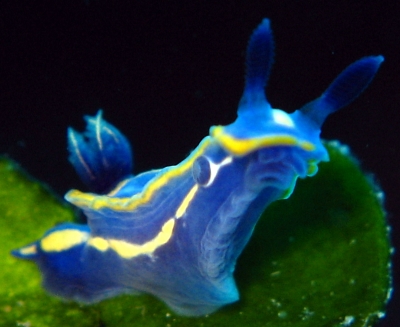
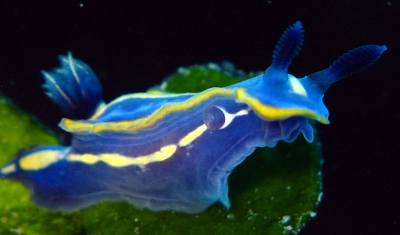
Hello Bill,
On these photos of an animal I've identified as Hypselodoris tricolor, I've noticed a strange spot on its flank. I really have no idea what this spot could be. Would you have any suggestion on this ?
Locality: Cap d'Antibes, 18m, Antibes, France, Mediterranean sea, 25 June 2006, vertical rock. Length: 18mm. Photographer: Dominique Horst.
Many thanks in advance for your help,
Kind regards,
Dominique
dominique.horst@wanadoo.fr
Horst, D., 2006 (Jun 28) Strange structure on Hypselodoris tricolor. [Message in] Sea Slug Forum. Australian Museum, Sydney. Available from http://www.seaslugforum.net/find/17001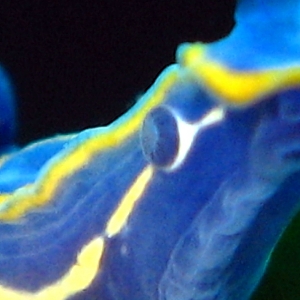
Dear Dominique,
The 'strange spot' is the opening to the reproductive organs. All sea slugs are hermaphrodite with functional male and female systems. As they do not fertilise their own eggs, they still need to mate with another partner, but when mating, they usually act as male and female simultaneously. In nudibranchs, the reproductive ducts - the penis, vagina, and usually a second 'female' opening for outgoing eggs - all open together on the right side of the body behind the head. They open into a small internal sac or genital vestibule, but during mating, the vestibule everts - like the finger of a rubber glove - so that openings become functional. In your photo, the 'vestibule' is partially everted. In some cases the structures are very elaborate like in Roberto Sozzani's Nembrotha photos [see message #13711]
Best wishes,
Bill Rudman
Hypselodoris tricolor - feeding ?
June 21, 2006
From: Kerem Turker
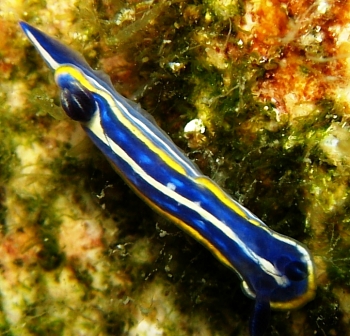
Dear Bill,
I have been diving in Turkish waters for nearly 7 years and I have not seen this nudi even once before.
After an extensive search in the forum, I think that it is Hypselodoris tricolor. I have spent quite some time with the nudi, and I am pretty sure that it is feeding on the green sponges attached to the rocky surface.
Locality: Bodrum - Kargi , 25 to 30 meters, Turkey, Mediterranean, 18 June 2006, Rock surface with sponges. Length: less than 10 mm. Photographer: Kerem Turker.
Best Regards,
Kerem
kerem.turker@pmintl.com


Dear Kerem,
I agree with your identification of the chromodorid, but I am pretty sure the greenish organism in your photo is a filamentous green algae. H. tricolor is reported to feed on the sponge Dysidea avara which ranges from a whitish grey to a pinkish colour and has a distinctive shape and texture which you can see in Bali Yokes photos [message #5338 ]. The green algae may be growing on a pale cream sponge but I don't think so. Nudibranchs at times can be very infuriating. You can sit and watch them for a long time and they seem to be very busy and purposeful, when in fact all they are doing is slowly feeling and sensing everything they come in contact with. I suspect that if a food sponge is nearby their rhinophores will sense its presence, but when they can 'smell' nothing, they just search methodically - but not necessarily successfully, as you observed.
Best wishes,
Bill Rudman
Re: Another Hypselodoris from Portugal
April 26, 2006
From: Marina Poddubetskaia Ossokine
Concerning message #16336:
Dear Bill and David,
In this animal the rhinophores are plain blue, so it couldn't be H. bilineata (nor H. cantabrica ).
According to the mantle and foot pattern and hidden gills, I think this animal is Hypselodoris tricolor. H. tricolor is more sensible than other blue dorid species. At any disturbance, it tends to hide its gills and sometimes it takes up to 5 minutes to see the gills again. Of course, it doesn't mean all blue dorids with hidden gills are H. tricolor, but it could be an additional clue...
Best regards,
Marina.
nembro@nembro.info
Poddubetskaia Ossokine, M., 2006 (Apr 26) Re: Another Hypselodoris from Portugal. [Message in] Sea Slug Forum. Australian Museum, Sydney. Available from http://www.seaslugforum.net/find/16443Thanks Marina,
Familiarity with local populations often gives us valuable little behavioural clues like this.
Best wishes,
Bill Rudman
Re: Another Hypselodoris from Portugal
April 26, 2006
From: Juan Lucas Cervera
Concerning message #16336:
Hi Bill,
I feel that this species is Hypselodoris midatlantica.
Regards.
Lucas.
lucas.cervera@uca.es
Cervera, J.L., 2006 (Apr 26) Re: Another Hypselodoris from Portugal. [Message in] Sea Slug Forum. Australian Museum, Sydney. Available from http://www.seaslugforum.net/find/16451Thanks Lucas,
You will see that Marina Poddubetskaia Ossokine has made the same suggestion - under the name H. tricolor. As I have commented in an earlier message [#3807], it would be valuable if the question of H. tricolor versus H. midatlantica could be resolved, but as I see it, it will need a submission to the International Commission by a group of experts familar with the species.
Best wishes,
Bill Rudman
Another Hypselodoris from Portugal
April 24, 2006
From: David Abecasis
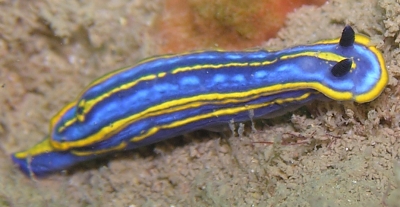
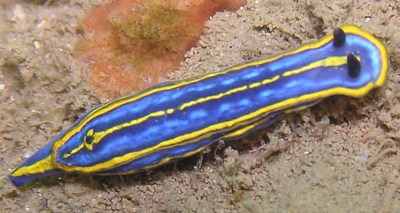
Hi Bill,
This is another Hypselodoris which I can't be sure of the species. Can you help me?
Locality: Faro, 16 metres, Portugal, Atlantic Ocean, 13 April 2006. Photographer: David Abecasis
Thanks,
David Abecasis
davidbecas@netcabo.pt
Abecasis, D., 2006 (Apr 24) Another Hypselodoris from Portugal. [Message in] Sea Slug Forum. Australian Museum, Sydney. Available from http://www.seaslugforum.net/find/16336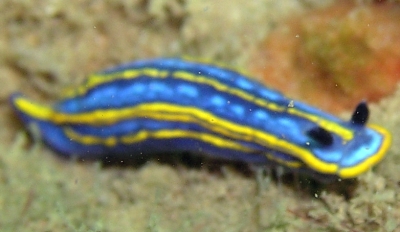
Dear David,
I am having difficulty finding clear differences between some of the species as reviewed in Ortea, Valdes & Garcia-Gomez, 1996. In this case this animal could be H. bilineata, H. tricolor or H. fontandraui. Unfortunately I can't see the colour of the gills in your photos and they may be the critical difference. Any help from local experts would be very welcome.
Best wishes,
Bill Rudman
Hypselodoris tricolor or H. fontandraui
June 24, 2005
From: Sylvain Le Bris

Dear Bill,
Please can you help me to identify these Hypselodoris. I think it is H. orsinii (on right) but for the other (on left) I wonder if it is H. fontandraui or H. tricolor?
These species are common in the Marseille area and each time I have the same problem for identification
Locality: Planier Island, Marseille. France. Mediterranean Sea. Depth: 14 m. Length: 12 mm. 19 June 2005. Photographer: Sylvain Le Bris
Thanks for your help
Sylvain Le Bris
sylvain.lebris@freesbee.fr
Le Bris, S., 2005 (Jun 24) Hypselodoris tricolor or H. fontandraui. [Message in] Sea Slug Forum. Australian Museum, Sydney. Available from http://www.seaslugforum.net/find/14085
Dear Sylvain,
The one on the tight is H. orsinii. It feeds on the sponge Cacospongia, which is what it is crawling on. In an earlier message [#7383], Jean-Pierre Bielecki notes that this species could be distinguished by minute tubercles on the back, which you can clearly see them in your photo alongside.
I am sure the other species if H. tricolor, but as it feeds exclusively on species of Dysidea, I am puzzled tp see it by Cacospongia. Perhaps you have placed by it by the H. orsinii for this photo?
Best wishes,
Bill Rudman
Re: Hypselodoris tricolor from Croatia
October 8, 2003
From: Adam Petrusek
Dear Bill,
I agree with your suggestion, the small H. tricolor was probably interested in the other sponge. I have checked the original hi-res image and indeed, there is a small and probably damaged sponge that looks like Dysidea ..
Thank you for the identification!
Adam
petrusek@cesnet.cz
Petrusek, A., 2003 (Oct 8) Re: Hypselodoris tricolor from Croatia. [Message in] Sea Slug Forum. Australian Museum, Sydney. Available from http://www.seaslugforum.net/find/11172Thanks Adam,
Bill Rudman
Hypselodoris tricolor from Croatia
October 7, 2003
From: Adam Petrusek

Dear Bill,
To accompany my earlier message here are photos of a dorid from Vrulja, on Makarska Riviera, Adriatic Sea, Croatia, on September 16, 2003.
Two show the species during and after mating
depth 31 m. The lower right showa one small (1 cm) dorid on Reniera fulva
depth ~20 m
I guess they are some Chromodoris(?)
Thanks for any help identifying them.
Adam Petrusek
petrusek@cesnet.cz


Dear Adam,
These are one of the famous 'blue hypselodorids which are found in the Mediterranean and nearby Atlantic. They have caused many identification problems over the years so I am hesitant to identify them from so far away. However I am pretty sure these animals are Hypselodoris tricolor. This species seems to feed specifically on species of the sponge genus Dysidea so it is possible that rather than being interested in the reddish Reniera in your photo, the single animal is interested in the greyish sponge in the upper half of the photo which could be a species of Dysidea.
We still have much to learn about colour variation in this group of species, so photos of different sized animals, of them feeding and of them laying eggs would be very valuable additions to the Forum
Best wishes
Bill Rudman
Hypselodoris tricolor or H. bilineata from Turkey
July 26, 2003
From: Ferda Buyukbaykal
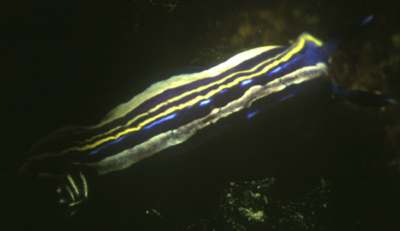
Hello Bill,
I found a new nudibranch at Ayvalik [Aegean Sea coast, Turkey] this weekend [July 2003].
It was 28-30 mt deep, algae and stone bottom and size 5-6 cm.
I think about its name is Hypselodoris tricolor or H. midatlantica. Which is correct.?
Ferda Buyukbaykal
ferdabbaykal@isnet.net.tr

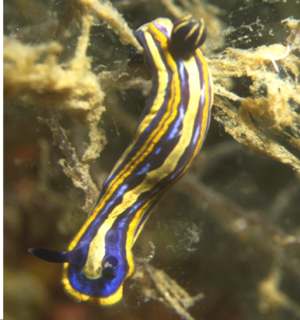
Dear Ferda,
I guess this is what I am calling Hypselodoris tricolor [see discussion about whether we should use H. midatlantica instead]. However the form of H. tricolor in which the median yellow line appears to be two lines fused together looks remarkably like some specimens of Hypselodoris bilineata. The only external difference I can see is that in H. bilineata there are yellow markings on the posterior edge of the rhinophore pocket and in a line up the rhinophore club. In your bottom right photo there does seem to be some yellow on the back of the rhinophore. Could you have a look at your photos and see if any of them shows some yellow markings on the rhinophores? If they do then this may be H. bilineata.
Best wishes,
Bill Rudman
Hypselodoris tricolor from French Mediterranean
June 24, 2002
From: Marina Poddubetskaia

Dear Bill,
Could you confirm, please, the identification of this blue doris. I think it's Hypselodoris tricolor.
• Upper right, Lower left:
Cap Croisette (near Marseille), France. Site: Passe de Maire. Depth: 14m, Size: about 15 mm, June 05, 2002
• Lower Right:
Cap Croisette (near Marseille), France. Site: Pierre qui tramole. Depth: 16m, Size: about 15 mm. June 04, 2002
Best wishes,
Marina.
www.nembro.info
nembro@nembro.info
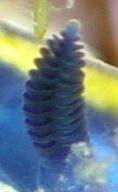

Dear Marina,
This seems to fit what some people are calling H. tricolor and others think should be called Hypselodoris midatlantica. As I discuss in earlier messages this disagreement can only be resolved by the International Commission.
Best wishes,
Bill Rudman
Hypselodoris tricolor from Spain
October 29, 2001
From: Luis Sánchez Tocino

Dear Dr. Rudman
Here are some photos of Hypselodoris tricolor from Almuñecar, Granada Coast of Spain.
A. size 30 mm; depth 10 m; March 1997
B. size 20 mm; depth 6 m; March 1997
C. size 25 mm; depth 7 m; March 1999
D. size 20 mm; depth 6 m; March 1997
E. size 35 mm; depth 6 m; May 1998
I have sent a photo of a juvenile and close-up photos of body parts in separate messages.
Luis
lstocino@ugr.es


Thanks Luis,
Bill Rudman
Juvenile of Hypselodoris tricolor from Spain
October 29, 2001
From: Luis Sánchez Tocino

Dear Dr. Rudman
Here is a photo of a juvenile of Hypselodoris tricolor from Almuñecar, Granada Coast of Spain.
Size 8 mm; depth 5 m; June 1998
Luis
lstocino@ugr.es
Sánchez Tocino, L., 2001 (Oct 29) Juvenile of Hypselodoris tricolor from Spain. [Message in] Sea Slug Forum. Australian Museum, Sydney. Available from http://www.seaslugforum.net/find/5540Thanks Luis,
Bill Rudman
More photos of Hypselodoris tricolor
October 29, 2001
From: Luis SánchezTocino

Dear Dr. Rudman
Here are some close-up photos of Hypselodoris tricolor to show particulat parts of their body. They are from Almuñecar, Granada Coast, Spain.
Luis
lstocino@ugr.es


Thnks Luis,
Bill Rudman
Re: Hypselodoris tricolor? from Italy
September 28, 2001
From: Juan Lucas Cervera
Dear Bill,
Checking the photos that are integrated in the Sea Slug Forum, I see there is one from the Ligurian Sea attributed to Hypselodoris messinensis by Roberto Moresco. In my opinion, this is a photo of H. midatlantica Gosliner, 1990 [see my message about H. midatlantica and H. tricolor]. During the last 25 years H. fontandraui (Pruvot-Fol, 1951) has often been misidentified as H. messinensis. It seems to me that "messinensis" is a junior synonym of H. villafranca (Risso, 1818). For more information, see Ortea, Valdes and Garcia-Gomez (1996) and Gosliner and Johnson (1999). It would be interesting to know the Terry Gosliner's opinion about these photos.
Cheers.
Lucas.
lucas.cervera@uca.es
Cervera, J.L., 2001 (Sep 28) Re: Hypselodoris tricolor? from Italy. [Message in] Sea Slug Forum. Australian Museum, Sydney. Available from http://www.seaslugforum.net/find/3912Thanks Lucas,
I must admit I had left these photos as H. messinensis until I could see a consensus. I still can't see how a photo like 9C in Ortea, Valdes and Garcia-Gomez (1996) - identified as H. fontandraui differs from those in Fig 8 which are identified as H. tricolor. It seems that these beautiful blue chromodorids have almost insoluble nomenclatural problems. I am sure I don't need to tell you that unless taxonomists can develop a stable nomenclature, any comparative studies on their chemistry and ecology are going to be meaningless. I really think there is a need for a group of European workers to prepare a case for the International Commission to suppress or stabilise some of the early names.
Good Luck,
Bill Rudman
Hypselodoris tricolor? from Turkey
September 28, 2001
From: Baki Yokes

Hi,
I had classified these animals as Hypselodoris messinensis, since they look very similar to the ones in the Atlas of Mediterranean Nudibranchs. Most of the specimens of this species from the North Aegean Sea are very colourful. They usually grow up to 3-4cm in size. They are found on rocky substrate and usually on this pink sponge (Dysidea avara?), at a depth deeper than 10m. A similar blue species [see other message] shares the same habitat, but it is smaller in size, has a more uniform color, and feeds on the sponge Cacospongia sp.
These photos were all taken at Saros Bay divesite, Canakkale, Turkey.
UPPER RIGHT: Depth: 20m; 35mm long, June 1999. Photo: Hasan Yokes: hyokes@turk.net.
LOWER LEFT: Depth: 12m; 25mm long, June 1999. Photo: Baki Yokes.
LOWER RIGHT: Depth: 20m; 30mm long, June 1999. Photo: Hasan Yokes
Best wishes,
Baki
bakiyokes@turk.net



PHOTO: Animals on sponge Dysidea avara?, Saros Bay divesite, Canakkale, Turkey. Depth: 20m; 30mm long, June 1999. Photo: Hasan Yokes
Dear Baki,
Thanks to you and Hasan for these photos. I think these are what has been called Hypselodoris tricolor but as you will see from Lucas's message, there is no simple solution. I haven't time to regularly change all the names on the Forum, as the argument sways one way or the other, so I am going to keep calling it H. tricolor on the Forum until the International Commission is asked to adjudicate on the matter. It appears to me that is the only way the matter can be resolved.
One problem I have is that in the most recent revision of these animals by Ortea, Valdés, & García-Gómez, (1996), there is another species Hypselodoris fontandraui which looks very similar in shape and radular morphology, and also feeds on Dysidea alvara. In some photos (Fig 9C for example) I can't see any differences between it and photos of H. tricolor. Angel Valdés is preparing a guide to these animals for the Forum. Hopefully his new job will not delay this greatly anticipated contribution much longer.
Best wishes,
Bill Rudman
Hypselodoris tricolor or H. midatlantica
February 15, 2001
From: Juan Lucas Cervera
Dear Bill,
This species is called by other authors (including me) Hypselodoris midatlantica Gosliner, 1990. Gosliner and Johnson's paper (1999) on the genus Hypselodoris supply a good discussion about the controversy of both names.
• Gosliner, T.M. & Johnson, R.F. (1999) Phylogeny of Hypselodoris (Nudibranchia: Chromodorididae) with a review of the monophyletic clade of Indo-Pacific species, including descriptions of twelve new species. Zoological Journal of the Linnean Society, 125: 1-114.
Cheers.
Lucas.
lucas.cervera@uca.es
Cervera, J.L., 2001 (Feb 15) Hypselodoris tricolor or H. midatlantica. [Message in] Sea Slug Forum. Australian Museum, Sydney. Available from http://www.seaslugforum.net/find/3807Thanks Lucas,
... and just when I was starting to feel confident about these blue chromodorids.
For those of you not familiar with the situation, there is one group who thinks they can identify Cantraine's Doris tricolor, and another group which consider that the original description is so poor that the name should be considered unidentifiable and so rejected. In an attempt to clarify the situation Ortea et al (1996) chose a neotype for Cantraine's Doris tricolor but Gosliner and others consider the specimen chosen does not accurately match the few features Cantraine mentioned in his inadequate description and urge that the neotype designation should be set aside. There is no way to resolve this dispute by continued debate or learned arguments. It is a good example of where the International Commission on Zoological Nomenclature should be asked to resolve the impasse. All I can do is urge the parties involved to prepare a case and submit it to the Commission. In the long run it does not really matter which solution they accept. The important point is that a solution should be reached. The blue chromodorids in the Mediterranean are an extremely interesting group biologically, but if the taxonomists can't decide which names to use, then taxonomists become the impediment to further scientific discovery and the ecologists and natural products chemists etc are not going to have a very high opinion of us.
Bill Rudman
Hypselodoris tricolor from Spain
February 14, 2001
From: Alma Sánchez


Dear Dr. Rudman,
Here are two photos of Hypselodoris tricolor (Cantraine, 1835). This specimen was collected in May, 2000 at the Bay of Algeciras (Strait of Gibraltar, Southern Spain) at 20 m. depth (17.6ºC), Size: 25 mm. Place: La Seca Reef.
The photos have been identified by Dr. Ángel Váldes.
Best wishes,
Alma Sánchez.
almasanchez83@hotmail.com
Dear Alma,
Thanks for the photos and thanks for getting Ángel to identify them first. Certainly saves me from making a mistake.
Best wishes,
Bill Rudman
Re: Hypselodoris tricolor?
January 27, 1999
From: Roberto Moresco
Dear Bill Rudman,
I' m very sorry. The photos that I sent earlier are of Hypselodoris messinensis, and not abaut Hypselodoris tricolor, some people call Hypselodoris messinensis also "coelestis".
Next photos will be of H. tricolor and of Umbraculum mediterraneum.
Roberto Moresco
Moresco@freeweb.amicus.it
Moresco, R., 1999 (Jan 27) Re: Hypselodoris tricolor?. [Message in] Sea Slug Forum. Australian Museum, Sydney. Available from http://www.seaslugforum.net/find/518Dear Roberto,
Thanks for the clarification. I look forward to the photos of H. tricolor and Umbraculum mediterraneum.
Bill Rudman.
Re: Hypselodoris tricolor
January 22, 1999
From: Erwin Koehler
Dear Bill,
I recommend the book:
Jesús Ortea, Ángel Valdés and José Carlos García-Gómez, (Avicennia, 1996, Sup. 1) Revisión de las especies atlánticas de la familia Chromodorididae (Mollusca: Nudibranchia) de grupo cromático azul. [Review of the Atlantic species of the family Chromodorididae (Mollusca: Nudibranchia) of the blue chromatic group.]
You can buy this book (165 pages, lots of photos, for example 6 of Hypselodoris bilineata) for 8.000 pts at
Dr. Jesús Ortea,
Depto. de Biología de Organismos y Systemas Laboratorio de Zoología
Universidad de Oviedo
33075 Oviedo, Asturias
Espana.
The book has a small English/Spanish section, the complete text is Spanish.
H. messinensis ==> H. fontandraui (Pruvot-Fol, 1951)
H. coelestis ==> H. fontandraui(Pruvot-Fol, 1951)
H. webbi ==> H. picta (Schultz, 1836)
H. elegans ==> H. picta (Schultz, 1836)
H. valenciennesi ==> H. picta (Schultz, 1836)
Erwin
E.Koehler@deutschepost.de
Koehler, E., 1999 (Jan 22) Re: Hypselodoris tricolor. [Message in] Sea Slug Forum. Australian Museum, Sydney. Available from http://www.seaslugforum.net/find/507Hypselodoris tricolor? from Italy
January 21, 1999
From: Roberto Moresco
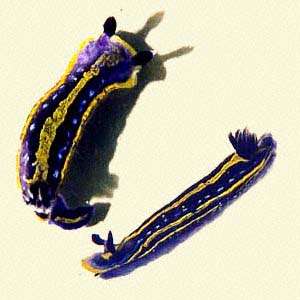
Dear dr.Bill Rudman,
I writing to tell you that I have sent you by mail some photos of our adults of Hypselodoris tricolor, collecting in Mar Ligure, and living now in Acquario di Genova. [Ligurian Sea, north western Italy. 25mm long alive.]
Good new year.
Roberto Moresco
Genova
Italy
moresco@freeweb.amicus.it
Moresco, R., 1999 (Jan 21) Hypselodoris tricolor? from Italy. [Message in] Sea Slug Forum. Australian Museum, Sydney. Available from http://www.seaslugforum.net/find/500Dear Roberto,
Thanks for the photos. I am very interested in the blue chromodorids from the Mediterranean because they show a mimicry very similar to the red-spotted species in south-eastern Australia. It would be good to have photos of the other Mediterranean species for comparison as it is such a good example of colour mimicry.
I am not an expert on Mediterranean chromodorids so I hesitate to suggest that your animals may not be H. tricolor but they look very like the animal illustrated in the Atlas of Mediterranean Nudibranchs (Pl 4, fig 6) as Hypselodoris messinensis.
Also, in your earlier message you describe the larvae as lasting for some days as feeding veligers, while Haefelfinger (1969) suggests that H. tricolor has direct development, with no veliger stage. Haefelfinger also reports that H. messinensis has much smaller eggs indicative of planktotrophic larvae. Is it possible you have H. messinensis or did Haefelfinger misidentify his material? Most, but not all, photos I have seen identified as H. tricolor are of a dark blue animal with a yellow-orange border and a white median line. Is that just one colour form of the species? I would be very interested in your thoughts.
Best wishes
Bill Rudman.
References:
• Cattaneo-Vietti, R., Chemello, R. & Gianuzzi-Savelli, R. (1990). Atlas of Mediterranean Nudibranchs. La Conchiglia: Rome.
• Haefelfinger, HR., 1969. Contribution a la systematique des Glossodoridiens mediterraneens (Gastropoda, Opisthobranchia). Rev. Suisse Zool.,76: 703-710.
